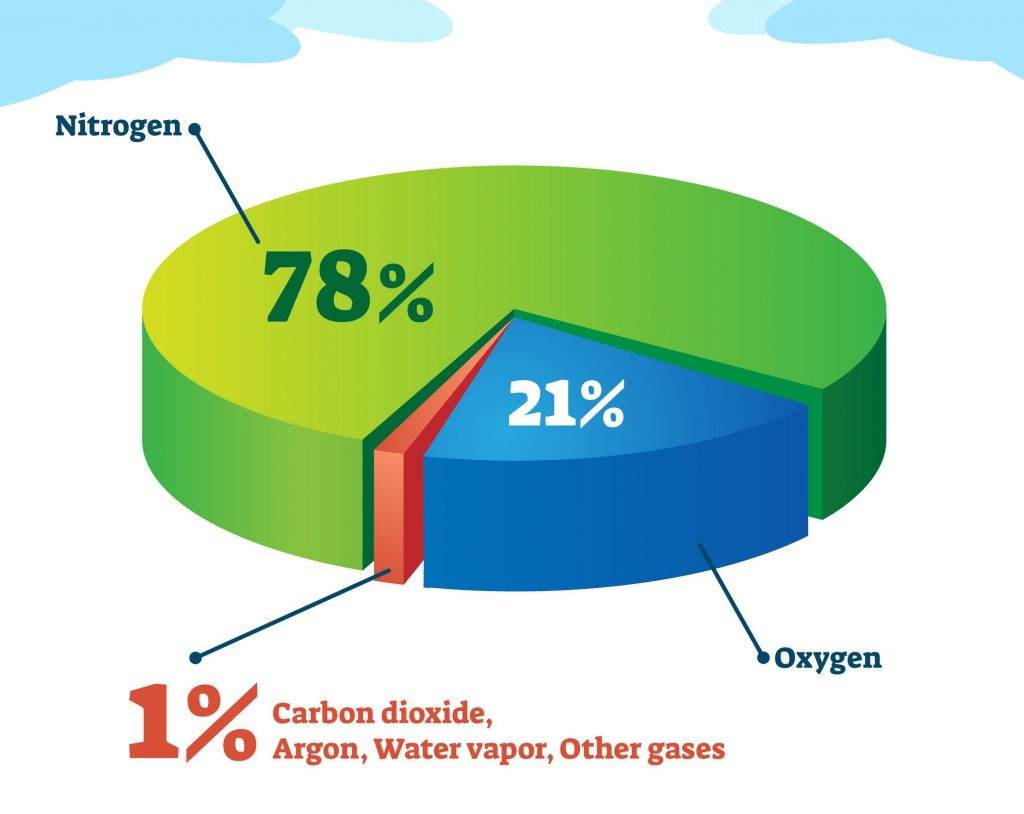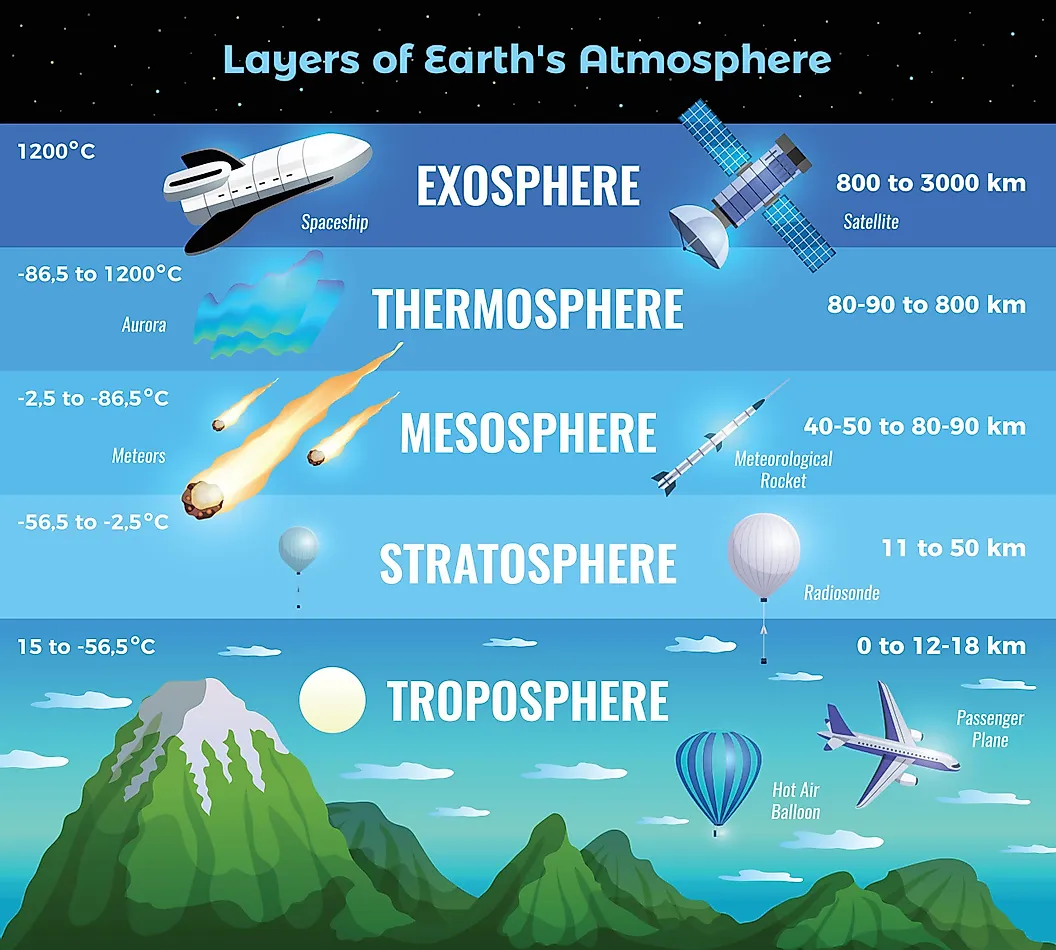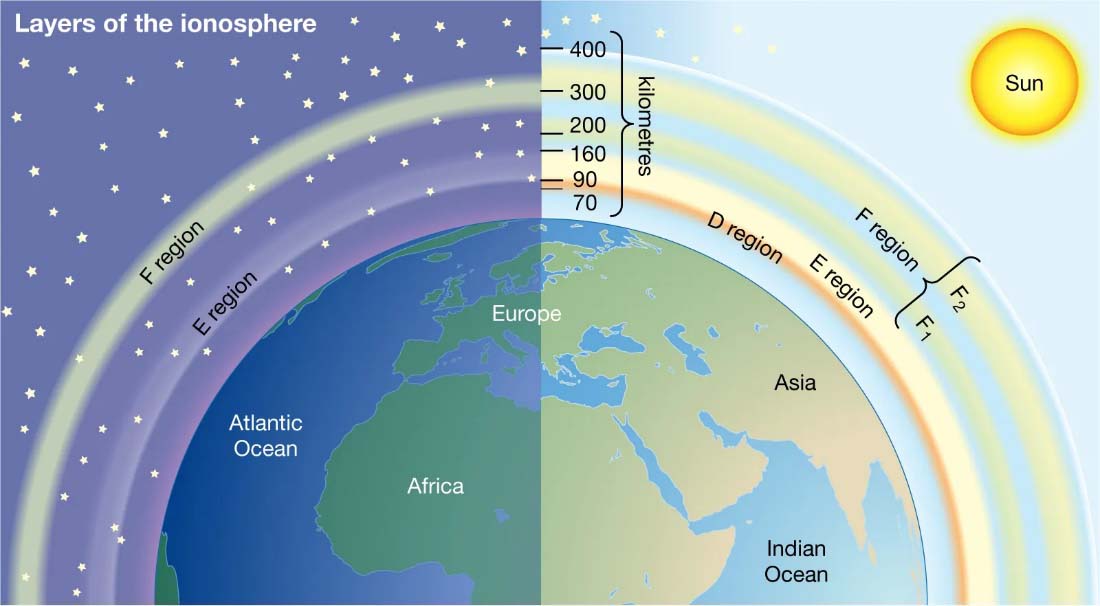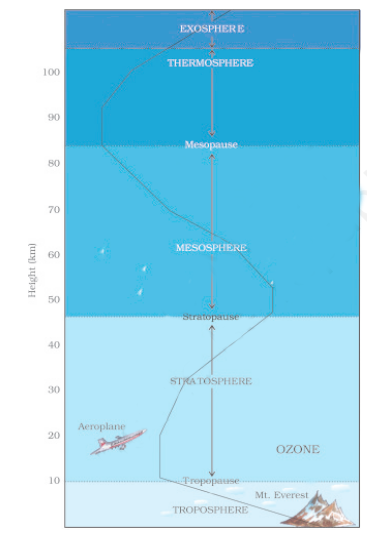Composition and Layers of Earth's Atmosphere | 13 Apr 2023
For Prelims: Atmosphere & Its Layers, Composition of Earth’s Atmosphere
For Mains: Significance of Atmosphere, Characteristics of Different Layers of Atmosphere
What is there to Know About the Atmosphere?
- About:
- One of the main components of Earth’s interdependent physical systems is the atmosphere. An atmosphere is made of the layers of gases surrounding a planet or other celestial body.
- Composition:
- Earth’s atmosphere is composed of about 78% nitrogen, 21% oxygen, and 1% other gases.
- Nitrogen (N2): It is the most plentiful gas in the air. It is one of the primary nutrients critical for the survival of all living organisms.
- Oxygen (O2): Humans and animals take oxygen from the air as they breathe. Green plants produce oxygen during photosynthesis. In this way oxygen content in the air remains constant.
- Carbon dioxide (CO2): It is an important heat-trapping gas, or greenhouse gas, that comes from the extraction and burning of fossil fuels.
- These gases are found in atmospheric layers defined by unique features such as temperature and pressure.
- Earth’s atmosphere is composed of about 78% nitrogen, 21% oxygen, and 1% other gases.
What are the Different Layers of the Atmosphere?
- Troposphere:
- Earth’s troposphere extends from Earth’s surface to, on average, about 12 kilometers in height, with its height lower at Earth’s poles and higher at the equator.
- Yet this very shallow layer is tasked with holding all the air that plants need for photosynthesis and animals need to breathe, and also contains about 99% of all water vapor and aerosols (minute solid or liquid particles suspended in the atmosphere).
- The temperature in the troposphere also decreases with height. On top of this layer is what is referred to as tropopause.
- It is the densest atmospheric layer, compressed by the weight of the rest of the atmosphere above it.
- Most of Earth’s weather happens here, and almost all clouds that are generated by weather are found here.
- Most aviation takes place here, including in the transition region between the troposphere and the stratosphere.
- Earth’s troposphere extends from Earth’s surface to, on average, about 12 kilometers in height, with its height lower at Earth’s poles and higher at the equator.
- Stratosphere:
- Located between approximately 12 and 50 kilometers above Earth’s surface, the stratosphere is perhaps best known as home to Earth’s ozone layer.
- In this region, the temperature increases with height. Heat is produced in the process of the formation of Ozone, and this heat is responsible for temperature increase.
- It is nearly cloud- and weather-free, but polar stratospheric clouds (occur mainly at high latitudes during the winter) are sometimes present in its lowest, coldest altitudes.
- It’s also the highest part of the atmosphere that jet planes can reach.
- Mesosphere:
- Located between about 50 and 80 kilometers above Earth’s surface, the mesosphere gets progressively colder with altitude.
- The top of this layer is the coldest place found within the Earth system, with an average temperature of about minus 85 °C (-120 °F).
- The very scarce water vapor present at the top of the mesosphere forms noctilucent clouds, the highest clouds in Earth’s atmosphere.
- Most meteors burn up in this atmospheric layer. Sounding rockets and rocket-powered aircraft can reach the mesosphere.
- The transition boundary which separates the mesosphere from the stratosphere is called the stratopause.
- Located between about 50 and 80 kilometers above Earth’s surface, the mesosphere gets progressively colder with altitude.
- Thermosphere:
- It is located between about 80 and 700 kilometers above Earth’s surface, whose lowest part contains the ionosphere.
- Because this layer is much closer to the sun, it can reach temperatures up to 2,000 °C (3,600 °F)
- In this layer, temperatures increase with altitude due to the very low density of molecules found here. It is both cloud- and water-vapor-free.
- The aurora borealis (Northern lights) and aurora australis (Southern lights) are sometimes seen here.
- The International Space Station (ISS) orbits in the thermosphere.
- Ionosphere:
- It is not a distinct layer as the others mentioned above. Instead, the ionosphere overlaps the mesosphere, thermosphere, and exosphere.
- It’s a very active part of the atmosphere, and it grows and shrinks depending on the energy it absorbs from the sun.
- It is an electrically conducting region capable of reflecting radio signals back to Earth.
- The electrically charged atoms and molecules that are formed in this way are called ions, giving the ionosphere its name and endowing this region with some special properties.
- It is located between about 80 and 700 kilometers above Earth’s surface, whose lowest part contains the ionosphere.
- Exosphere:
- It is located between about 700 and 10,000 kilometers above Earth’s surface, the exosphere is the highest layer of Earth’s atmosphere and, at its top, merges with the solar wind.
- Molecules found here are of extremely low density, so this layer doesn’t behave like a gas, and particles here escape into space.
- While there’s no weather in the exosphere, the aurora borealis and aurora australis are sometimes seen in its lowest part.
- Most Earth satellites orbit in this layer.
- Significance:
- Protection from Harmful Radiations: The atmosphere protects life on Earth by shielding it from incoming ultraviolet (UV) radiation, keeping the planet warm through insulation, and preventing extremes between day and night temperatures.
- Weather and climate: The atmosphere play a crucial role in determining weather and climate patterns, including temperature, precipitation, and wind. These patterns have a significant impact on ecosystems, agriculture, and human activities.
- Regulates the Earth's Temperature: The atmosphere helps regulate the Earth's temperature by trapping heat from the sun and preventing it from escaping into space. This process, known as the greenhouse effect, helps keep the planet warm enough to support life.
- A Major Role in the Water Cycle: The atmosphere helps regulate the Earth's water cycle by transporting water vapor from the oceans to the land, where it falls as precipitation.




